Northern Pakistan, home to stunning valleys like Hunza, Swat, Skardu, and Kaghan, draws millions each summer for its cool weather, glaciers, and breathtaking scenery. But with changing climate patterns, the region now faces growing hazards: flash floods, Glacial Lake Outburst Floods (GLOFs), landslides, and collapsing roads during the monsoon season (June–September).
In 2025, early rains and glacial melt have already triggered emergency warnings across Gilgit-Baltistan and Khyber Pakhtunkhwa. Authorities have flagged areas like Chitral, Skardu, Astore, and Babusar Top as high-risk zones. Roads like the Karakoram Highway and Babusar Pass may face sudden closures or washouts.
Here, we are highlighting which regions to avoid, where it’s safer to go, and how to plan a smarter and safer adventure this summer. Stay informed, and stay safe.
Travelling North Pakistan in Summer: Climate Risks During Summer
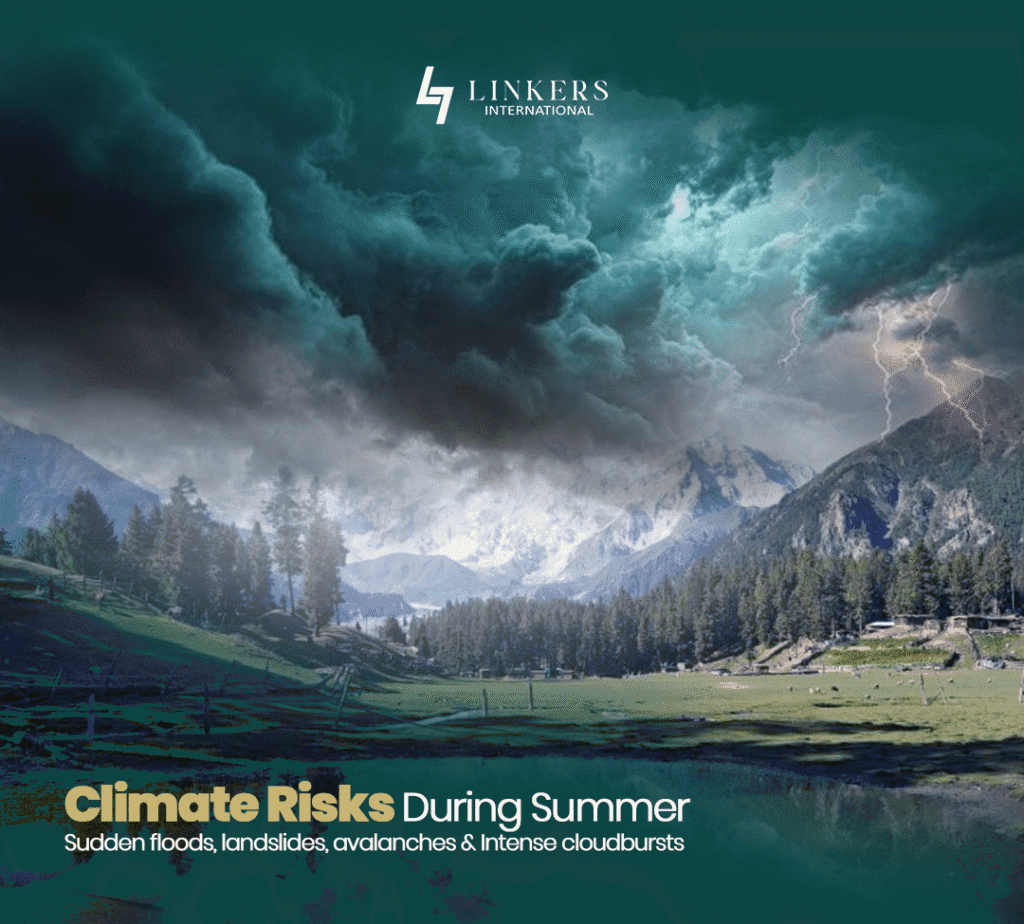
High mountain valleys in Northern Pakistan are prone to sudden floods, landslides, and avalanches during the monsoon (roughly June–September). Intense cloudbursts and torrential rains can trigger flash floods in steep streambeds, overwhelming bridges and washing out vehicles. Tourists are advised to stay alert in 2025 in northern areas like Gilgit, Hunza, Skardu, Astore, and Chitral. Intense rain and heat-driven glacial melt have made valleys and roads (including parts of the Karakoram Highway) especially unstable. NDMA has issued alerts for multiple high-risk zones.
If you’re planning a visit this summer, stay updated, avoid glacier-fed rivers and lakes, and prioritize safety over scenery.
High-Risk Areas to Avoid
Based on recent incidents and official warnings, certain northern areas are especially hazardous in summer:
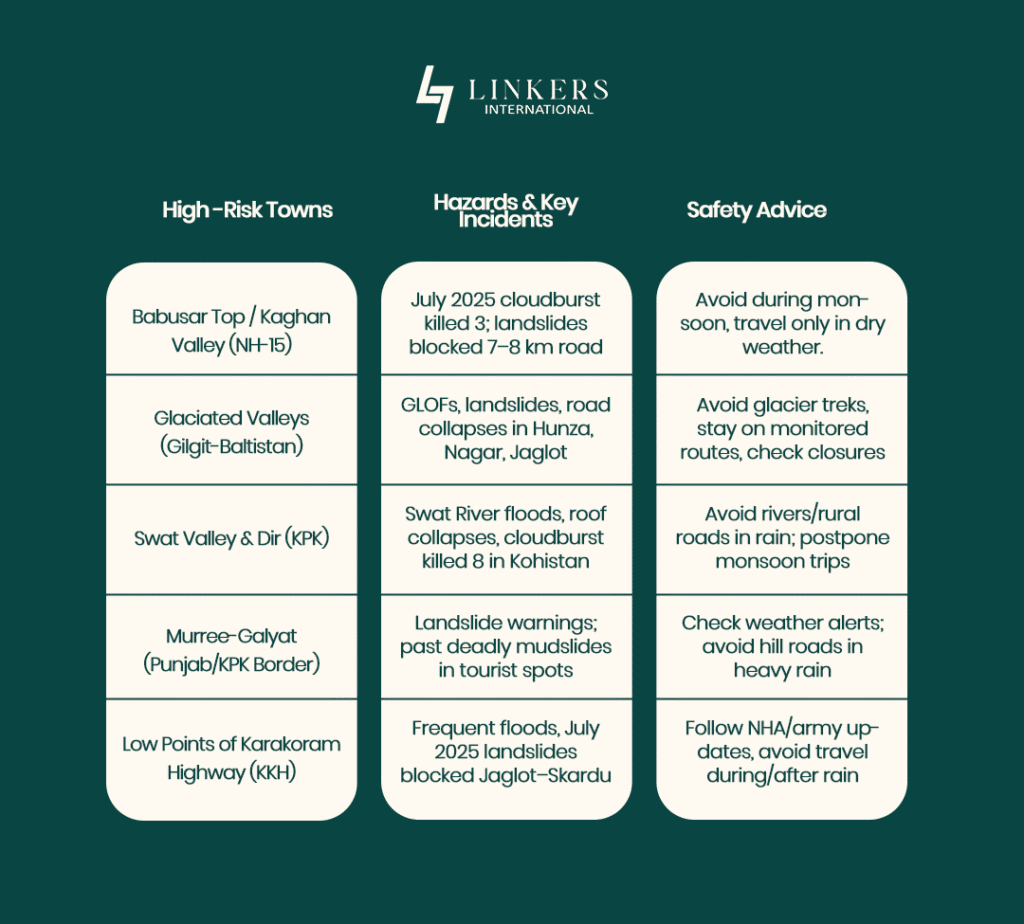
Babusar Top / Kaghan Valley (NH-15) – faces frequent closures during monsoon due to floods and landslides. In July 2025, a cloudburst swept away vehicles and blocked 7–8 km of road, killing three tourists. Authorities often halt traffic between Naran and Babusar Top for safety. Advice: Avoid this route during monsoon—even lower areas like Jalkhad and Naran saw major landslides in July.
Gilgit-Baltistan’s glaciated valleys – face extreme GLOF and landslide risks, especially in areas like Reshun-Booni (Chitral), Darkut/Hundur (Astore), Sadar (Hunza), and Barpu (Diamer). After heavy rain, roads in Hunza, Nagar, and Skardu’s Jaglot route are vulnerable to collapse. In July 2025, floods washed away bridges, stranding tourists in Skardu and Ghanchi. Advice: Avoid glacier treks or remote lakes—stick to monitored main highways like the KKH, though even these may face temporary closures.
Swat Valley and Dir (KP) – Although lower-elevation than Gilgit-Baltistan, northern KPK is monsoon-prone. The Swat River has become especially dangerous: in June 2025, five members of a family drowned near Mingora, and roof collapses from saturated soil killed children in Madyan (Swat). An Irfan Gul report (local news) noted sudden overflow in Swat streams. Additionally, Lower Kohistan roads have seen fatal crashes: a June 2025 cloudburst sent a car and 8 people into a ravine. Advice: Beware river crossings in Swat/Dir and avoid travel on Kohistan roads during rain.
Murree-Galyat (Punjab/KPK border) – These hill stations can be affected by monsoon. In July 2025 the PMD warned of landslides and mudslides in vulnerable Galyat/Murree roads. (Indeed, previously in mid-2023 Murree’s crowds suffered deadly mudslides). Advice: Treat even touristy towns with caution: check local bulletins and avoid heavy rain periods.
Karakoram Highway (KKH) low points – Several KKH sections in northern Punjab/KPK have chronic flood risk. For example, Tatta Pani (hot springs) road on KKH often collapses under heavy monsoon flows. In July 2025, KKH traffic was restored at Jaglot-Skardu only after relief crews cleared dozens of blocked points. Advice: If traveling the KKH northwards, monitor NHA and military reports; wait for “all-clear” on known flash points.
Riverbeds & Streams – Even outside major roads, do not picnic or camp near any mountain river. The GB government explicitly warned tourists in June 2025 to stay out of streams and nullahs, since a sudden surge can appear with little warning
In short, authorities advise: “Avoid traveling in high-risk mountainous areas during monsoon”. Heed local notices many districts have active emergency control rooms – and be prepared to change plans if weather turns bad.
Safer Alternative Destinations
While caution is essential, northern Pakistan still offers safe and enjoyable summer experiences with smart planning. Opt for well-established areas like Gilgit city, Karimabad in Hunza, or the Galyat region (Murree, Nathiagali, Ayubia), where roads and tourist facilities are better developed. Travel during periods outside flood alerts, and avoid remote or backroad treks. Even Islamabad’s Margalla Hills offer refreshing nature getaways close to urban safety and healthcare.
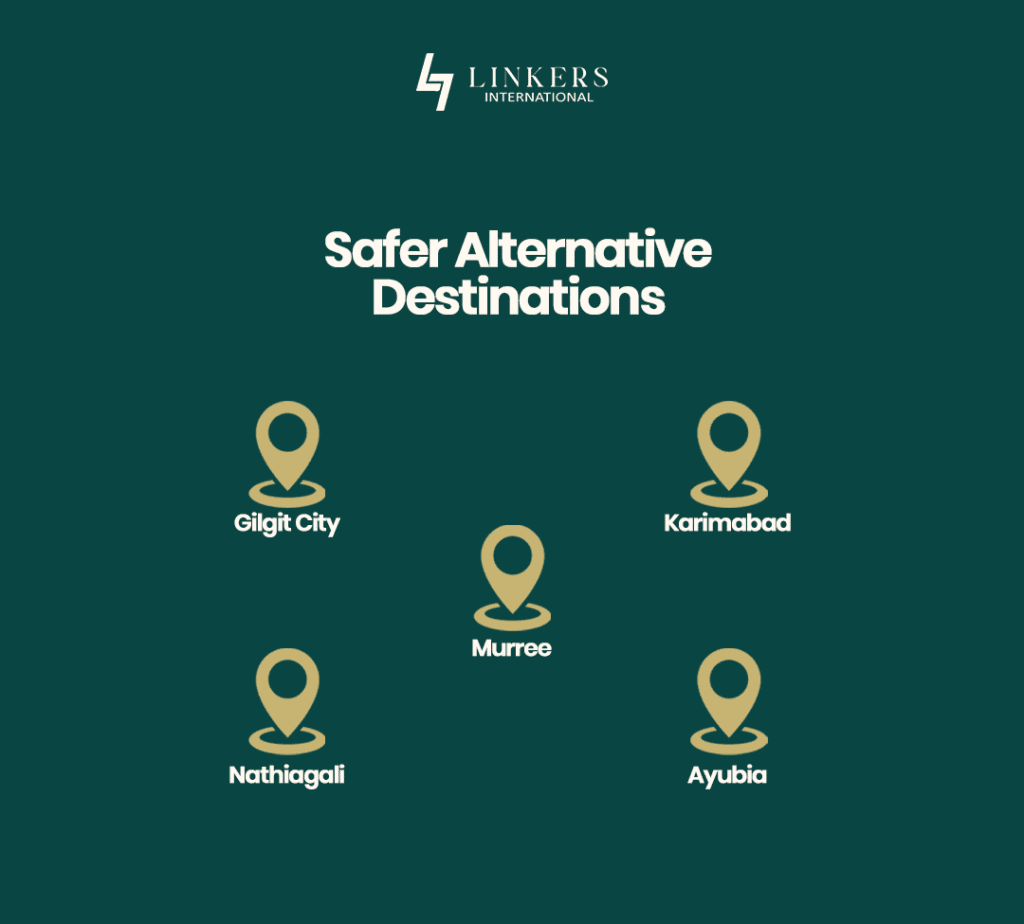
Timing is key. Plan trips for early summer (June–early July), before monsoon risks peak in August. Avoid lesser-known valleys under weather warnings, and consider alternate destinations during high-risk periods. Khyber Pakhtunkhwa’s tourism department runs a monsoon response unit with a 1422 helpline for support. For foreigners, hiring experienced local guides who track weather and road updates is strongly recommended.
Travel Safety Tips and Planning Advice
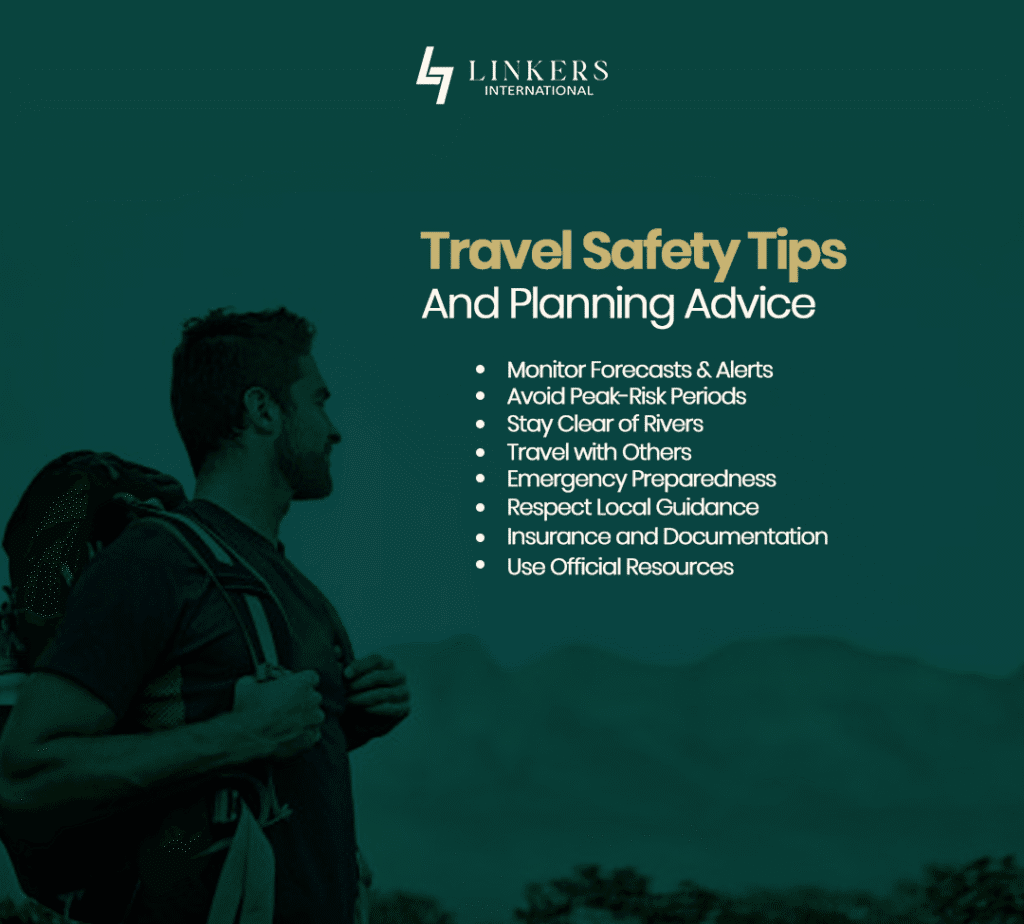
- Monitor Forecasts & Alerts: Regularly check NDMA/PDMA weather advisories and news. The NDMA issues bulletins of flood and landslide risk – for example, in July 2025, it warned of landslides in GB, KP, and AJKr. Always heed evacuation orders or area closures.
- Avoid Peak-Risk Periods: Do not travel during heavy rain or immediately after. As NDMA guidelines stress, “avoid travelling during periods of heavy rainfall” and stay away from steep slopes or streambeds during storms. If you must travel, do so in daylight and in convoy. Let someone (hotel or local contact) know your itinerary.
- Stay Clear of Rivers: Never camp or swim in mountain rivers in summer. The GB authorities specifically advised tourists to avoid riverbanks and nullahs during the GLOF warning period. Even a calm stream can turn deadly with runoff.
- Travel with Others: It’s safer not to trek or drive alone. NDMA advises against solo travel in hazardous areas. Use guided tours where possible, or at least travel with local drivers who know the roads.
- Emergency Preparedness: Carry a mobile phone (with power bank and local SIM), a first-aid kit, water, and warm layers. Pack a torch and signal whistle. Inform your embassy or local friends of your plans. In case of entrapment by floods, stay put on high ground – do not try to swim to safer land unless absolutely necessary.
- Respect Local Guidance: Observe roadblocks and warnings. For instance, Diamer District in GB has an emergency control room (05812-920181) during Babusar closures. Police and rescue personnel will direct traffic; do not bypass these checkpoints.
- Insurance and Documentation: Ensure you have comprehensive travel insurance that covers rescue (including helicopter evacuation). Keep photocopies of your passport and permits (Gilgit-Baltistan now requires permits for tourists outside Gilgit/Skardu city).
- Use Official Resources: KPK’s tourism authority set up a 1422 hotline for flood emergencies. Save such numbers and use them if stranded. Likewise, mountaineering authorities (like the Alpine Club of Pakistan) can advise on route conditions.
In July 2025, even cities in the north saw record rains. Islamabad recorded 184 mm in 24 hours, flooding streets in Saidpur Village, and Peshawar’s roads were similarly inundated. Remember: “mountain hazards” can spill into urban areas. Always carry rainproof gear, and consult local news while traveling – city drainage can fail too.
Conclusion: Responsible Travel and Awareness
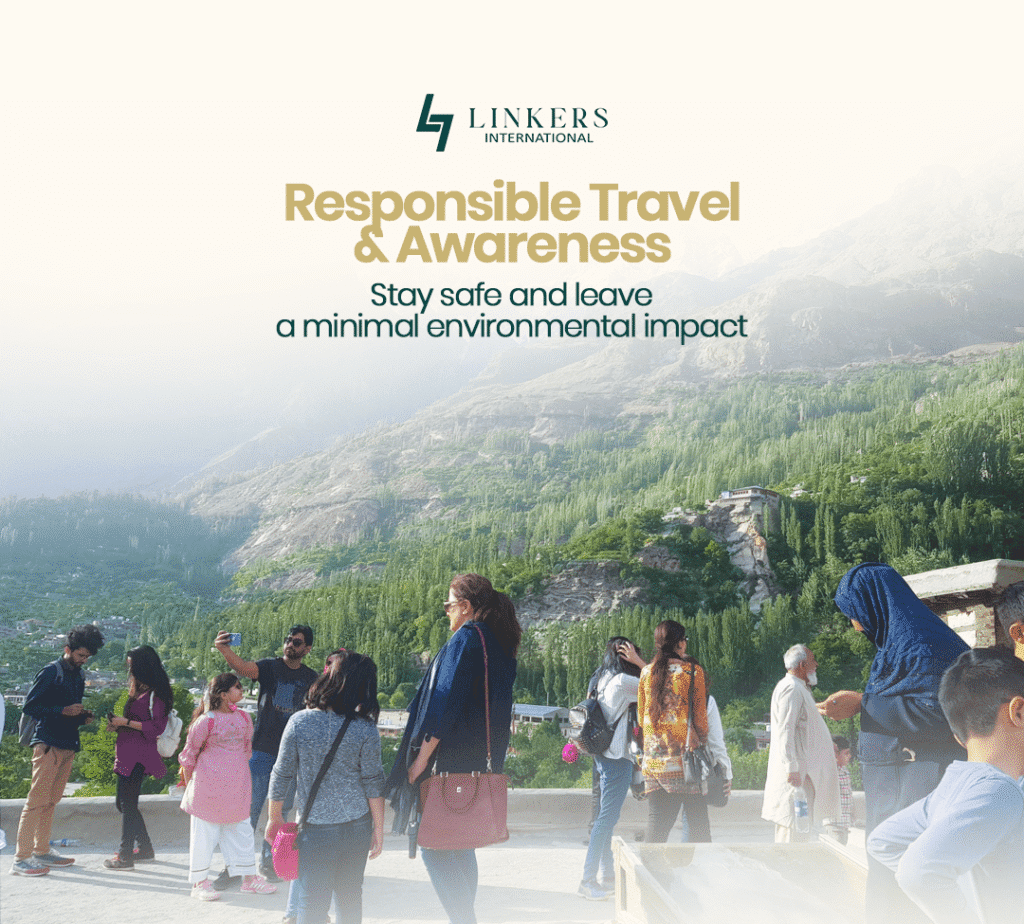
Northern Pakistan’s summer beauty is real, but so are its dangers. Travelers bear a responsibility to stay safe and leave a minimal environmental impact. Follow official advice, support local communities (e.g., hire local guides and services), and avoid reckless behavior like illegal camping or driving off-road in the rain. Every year’s floods teach a lesson: invest in preparedness. Experts emphasize water management and infrastructure improvements to mitigate future disasters, and tourists can aid this by promoting sustainable tourism (proper waste disposal, respecting signage, and advocating for local climate resilience).
Ultimately, enjoying Pakistan’s majestic north requires respect for nature’s power. Stay informed, travel wisely, and encourage conservation. This way, we can preserve these stunning landscapes for generations to come, while keeping ourselves and others safe from the growing climate risks.




